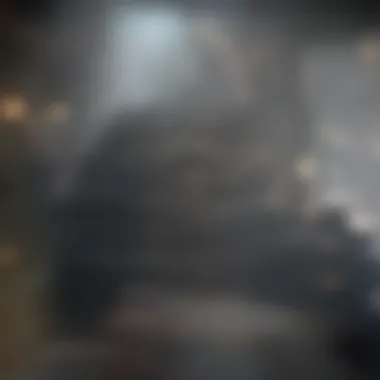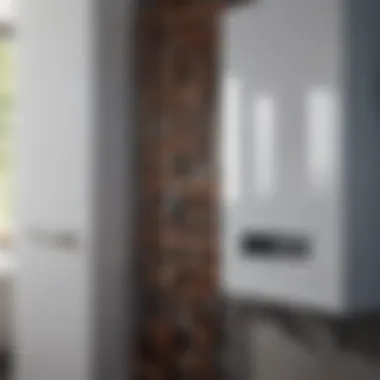Essential Guide to Home Inspections for Rental Properties


Intro
Home inspections for rental properties serve as a crucial element in maintaining the integrity of both the property and the tenant experience. The significance of these inspections cannot be overstated. They not only influence the overall property value but also play a fundamental role in tenant safety and compliance with local regulations. This article aims to unravel the multifaceted nature of home inspections tailored especially for rental spaces.
It is essential for landlords and property managers to recognize the various dimensions that inspections encompass. From evaluating structural elements to examining safety features, each aspect contributes to a comprehensive understanding of the property's condition. Through this guide, property owners, investors, and real estate professionals will gain insights into the inspection process, types of evaluations that may be conducted, and best practices that enhance both property management and tenant relationships.
"Regular inspections are a fundamental practice for landlords aiming to sustain asset value while ensuring tenant safety."
Feature Spotlight
Exceptional Architectural Designs
A well-maintained rental property often showcases its architectural merits. Inspections need to include evaluations of unique designs that may affect maintenance requirements. For instance, historical buildings may necessitate specialized repairs and preservation techniques. Recognizing these factors can bring about valuable insight into the financial implications and management needs of the property.
Factors that should be examined in this context include:
- Material durability: An inspection can reveal the properties of construction materials used. Brick, wood, or newer composites may require different upkeep strategies.
- Design integrity: Ensuring that features like moldings and fixtures remain functional and aesthetically pleasing requires careful attention.
Unique Decor Elements
In addition to structural elements, the inspection should address any unique decor aspects that can influence a tenant's experience. Custom interiors can highlight the property’s character but may involve specific maintenance requirements.
Key considerations might include:
- Custom flooring: The condition of hardwood or tile can significantly impact both safety and ambiance.
- Lighting fixtures: Unique fixtures may require specialized bulbs or installations that can affect energy efficiency.
Location Highlights
Must-Visit Neighborhoods
Understanding the area surrounding the rental property is equally important. Certain neighborhoods may have distinctive features that attract tenants, such as proximity to amenities or cultural experiences. Inspections can include an assessment of these elements, determining their impact on rental value.
Characteristics to note would include:
- Accessibility: Is there public transport nearby? How well are the roads maintained?
- Local amenities: The availability of grocery stores, parks, and schools plays a key role in tenant attraction.
Cultural and Historical Significance
Finally, the cultural context influences rental property desirability. If the neighborhood has historical relevance or cultural significance, this can enhance property value and appeal. Inspections in this regard should account for:
- Heritage preservation: Are there any restrictions or guidelines inherent to maintaining historical properties?
- Community involvement: Active neighborhood associations can provide insights into tenant demographics and expectations.
In summary, home inspections for rental properties are not just procedural tasks but strategic processes that can yield valuable insights for landlords and enhance tenant relationships. By understanding both the physical and contextual elements of the properties, owners can make informed decisions that ultimately foster greater satisfaction for all parties involved.
Prologue
Home inspections serve a crucial role in the realm of rental properties. For both landlords and tenants, these inspections can significantly affect various aspects of property management and living conditions. The process of understanding what a home inspection entails is vital for ensuring safety, staying compliant with local regulations, and ultimately protecting the investment.
A comprehensive inspection can unravel underlying issues that might not be visible at first glance. These include structural problems, electrical hazards, or plumbing failures that can lead to safety concerns or costly repairs down the line. Thus, recognizing the importance of detailed and thorough inspections becomes paramount for anyone involved in the rental property market.
For landlords, performing regular home inspections can maintain and enhance the property's value. This act demonstrates to tenants that you prioritize their safety and comfort, which establishes a foundation of trust. A proactive approach to property management not only helps mitigate risks related to liability but also contributes to tenant satisfaction, potentially leading to longer lease terms and reduced turnover.
Furthermore, having a structured home inspection process in place lays out a clear pathway for legal obligations. This helps landlords understand their responsibilities while ensuring tenant rights are respected. Home inspections cannot be seen as mere formalities; they play a strategic role in effective rental property management.
Understanding the comprehensive nature of home inspections is the first step towards ensuring a reliable and safe rental environment. In the following sections, we will delve deeper into the significance of these inspections, the specific processes involved, and what essential elements landlords should consider when evaluating their properties.
Importance of Home Inspection for Rental Properties
Home inspections for rental properties are an essential component of effective property management. They offer landlords an opportunity to identify issues that may affect the property value and ensure compliance with safety standards. A thorough inspection can catch potential problems early, saving time, money, and stress in the long term. It also serves as a proactive approach in maintaining the integrity of the property.
Protecting Property Value
Keeping a rental property in good condition starts with regular inspections. An inspection can spotlight structural defects, damage to the roof, or problems with the foundation. These issues might not be visible at first glance but can escalate if not addressed promptly. By maintaining the property's overall health, landlords can safeguard their investment. Additionally, a well-kept property is more attractive to potential renters, leading to higher occupancy rates.
- Property value stability.
- Attractiveness to high-quality tenants.
- Enhanced resale potential.
Ensuring Safety and Compliance
Safety is a non-negotiable aspect of renting out property. A professional home inspection evaluates various safety parameters such as electrical systems, gas lines, and fire safety measures. Compliance with local building codes and regulations is also assessed during this process. Failing to comply can result in legal issues and financial liabilities. Regular inspections help assure that all standards are met, protecting both landlords and tenants.
"Safety isn’t expensive; it’s priceless."
Building Trust with Tenants


Trust is crucial in the landlord-tenant relationship. When tenants see that a landlord conducts regular inspections, it shows a commitment to maintaining a safe and comfortable living environment. Open communication about the inspection process and sharing findings fosters transparency. Tenants are more likely to respect the property and feel satisfied knowing their concerns are taken seriously. This positive interaction contributes to tenant retention and ultimately enhances the overall rental experience.
- Improved tenant satisfaction.
- Higher retention rates.
- Positive referrals and reputation.
By placing importance on home inspections, landlords not only protect their properties but also develop trust with their tenants, ensure safety, compliance, and maintain property value over time.
Understanding the Home Inspection Process
The home inspection process is a critical phase for landlords managing rental properties. It serves as a preventive measure to ensure the longevity and safety of the building. This process requires careful planning and execution to capture all relevant details regarding the property’s condition. A thorough understanding of this process allows landlords to maintain their investment and provide safe living conditions for tenants. Additionally, comprehending each step involved leads to better decision-making in property management.
Preparing for the Inspection
Before an inspection occurs, several steps need to be taken to ensure it runs smoothly. Initially, landlords should choose a qualified inspector. They should look for someone experienced and certified, as qualifications vary significantly. When selecting the inspector, landlords might want to verify their credentials and read customer reviews.
Another essential aspect of preparation involves notifying tenants about the upcoming inspection. Proper communication ensures that tenants are prepared and can address any specific concerns regarding the property. This engagement positively impacts the landlord-tenant relationship and builds trust. Additionally, making necessary repairs or improvements before the inspection is prudent. This action allows for a more accurate assessment of the property’s current state.
Conducting the Inspection
During the actual inspection, the qualified inspector examines various components of the property. They evaluate areas such as the roof, foundation, plumbing, electrical systems, HVAC, and more. Each element is crucial because it contributes to the overall functionality and safety of the rental home.
An effective inspector utilizes a checklist while conducting the examination. This checklist ensures that no critical areas are overlooked. Some specific components included in the inspection may necessitate immediate attention, thus allowing landlords to address possible issues proactively.
Post-Inspection Documentation
After the inspection is complete, an extensive report is generated. This documentation lays out findings, highlighting both minor issues and major concerns. The report serves multiple purposes; it may guide the landlord in planning future maintenance or renovations. Moreover, it provides a clear account of the property's condition, which can be instrumental during disputes with tenants or insurance claims.
Landlords should keep this report organized and easily accessible, allowing for ongoing reference. This practice not only keeps a record of the property’s history but also reinforces the landlord's commitment to maintaining a safe living environment for their tenants.
Essential Elements to Evaluate
In the realm of rental property inspections, the evaluation of key elements stands as a cornerstone for effective management and tenant satisfaction. Identifying structural deficiencies, ensuring functional systems, and verifying the condition of appliances are all critical for maintaining a property’s value and safety. Thus, thorough assessment of each element not only secures the property for future use but establishes a foundation of trust with tenants.
Structural Integrity
Understanding and evaluating structural integrity is paramount. This aspect involves scrutinizing the property's foundation, walls, and roofing for signs of wear, cracks, or deterioration. An inspection should assess any structural damage that might compromise safety or lead to costly future repairs. For landlords, rectifying structural issues contributes significantly to preserving property value and ensuring tenant safety.
Landlords must perform regular inspections since even small issues, if ignored, can escalate into significant problems. For instance: sagging roofs, uneven floors, or cracks in the foundation can all be indicators of underlying issues that need to be addressed.
Electrical Systems
Electrical systems are integral to the functionality of rental properties. An evaluation should focus on the main electrical panel, wiring, outlets, and fixtures. It is crucial to check for outdated systems, signs of overheating, or any wiring that does not meet current codes. Faulty electrical systems pose serious safety hazards, including fire risks.
Landlords who ensure the integrity of the electrical system not only keep tenants safe but also reduce the potential for liability claims. Moreover, ensuring compliance with local building codes can avert costly legal battles down the line.
Plumbing Considerations
When evaluating plumbing systems, one must inspect pipes, water heaters, fixtures, and drainage systems. Check for leaks, corrosion, and proper water pressure. Poor plumbing can result in significant damage and costly repairs. Landlords should routinely assess plumbing to prevent water damage and ensure cleanliness.
Additionally, maintaining a functional plumbing system plays a vital role in tenant satisfaction. Tenants will appreciate the reliability of water supply, which enhances their living experience.
HVAC Functionality
Heating, ventilation, and air conditioning systems are the backbone of living comfort in any rental property. Inspecting these systems ensures they operate efficiently. This includes checking filters, gauges, and the overall system functionality. Neglected HVAC systems can lead to tenant complaints and increased energy costs.
Landlords should invest time in regular maintenance of their HVAC systems. An effective system not only contributes to tenant comfort but can also increase property value.
Exterior and Interior Conditions
Assessing both the exterior and interior conditions of a rental property should be prioritized. The exterior includes the roof, gutters, siding, and landscaping. An appealing exterior fosters positive first impressions and promotes tenant retention.
Internally, evaluate walls, flooring, and fixtures for cleanliness and damage. Attention to detail in these areas reflects a landlord's commitment to tenant satisfaction and the overall management of the property.
Appliance and Fixture Assessment
Finally, a thorough assessment of appliances and fixtures is essential. This includes checking for functionality and potential wear of items like stoves, refrigerators, washing machines, and bathroom fixtures. Any malfunctioning appliance can lead to tenant dissatisfaction and should be addressed promptly.
Landlords should keep a record of appliance age and condition, making informed decisions on repairs or replacements. Up-to-date appliances not only enhance tenant comfort, but they can also increase property desirability in the rental market.
Types of Home Inspections
When managing rental properties, understanding the different types of home inspections is crucial. Each type serves a specific purpose and can significantly influence both the property’s upkeep and tenant satisfaction. Evaluating these types helps landlords and property managers make informed decisions, ensuring a well-maintained property that meets legal standards and tenant expectations.
Pre-purchase Inspections


Before acquiring a rental property, a pre-purchase inspection is essential. This type of inspection is conducted to uncover potential issues that could affect the property's value or safety. Engaging a qualified inspector helps identify problems such as structural weaknesses, electrical hazards, or plumbing deficiencies. This due diligence is not only about assessing the current conditions but also about forecasting potential costs associated with repairs.
For landlords, a pre-purchase inspection is a vital step to ascertain whether the investment is worthwhile. It allows negotiation on the purchase price based on the findings. A thorough inspection can reveal whether an investment will generate sufficient rental income or lead to long-term expenses.
Routine Maintenance Inspections
Routine maintenance inspections are performed at regular intervals, typically once a year or biannually. This type of inspection ensures that systems and structures within the property are functioning correctly. Routine checks can identify wear and tear that may not be evident to tenants.
Landlords benefit from these inspections because they provide opportunities to address issues before they become major problems. Not only does this approach preserve the property’s condition, but it also enhances tenant safety and comfort. Tasks during the inspection may include:
- Examining HVAC systems
- Inspecting roofing and siding
- Checking for leaks in plumbing
By keeping the property in good repair, landlords can maintain higher property values and improve tenant retention.
Move-in/Move-out Inspections
Move-in and move-out inspections are critical for documenting the condition of a rental property. Conducted before new tenants move in and after they vacate, these inspections are essential in determining any damages or maintenance issues that arose during the tenancy.
A thorough move-in inspection aids in setting expectations and clarifying responsibilities. It protects both the tenant and the landlord by creating a baseline of the property's condition. Conversely, the move-out inspection ensures that the property is returned in acceptable condition, allowing for fair distribution of security deposits. It can help avoid disputes over property damages, maintaining a healthy landlord-tenant relationship.
By utilizing detailed checklists during these inspections and taking photographs, landlords can ensure accurate records that may be useful should disputes arise.
In summary, understanding the types of home inspections plays a significant role in effective rental property management. Each type caters to specific stages in the property lifecycle, emphasizing the importance of safeguarding both the property and the interests of tenants.
Legal Implications of Inspections
Understanding the legal implications of home inspections is crucial for landlords managing rental properties. Inspections are not merely a matter of routine; they carry responsibilities and obligations that can significantly affect the landlord-tenant relationship. Failing to adhere to legal standards can lead to potential disputes, financial repercussions, and damage to reputation. This section explores the essential aspects of tenant rights and landlord obligations, along with insurance and liability considerations.
Tenant Rights and Landlord Obligations
Every tenant has specific rights that landlords must respect. These rights often include the right to a habitable living environment, which encompasses safety and proper maintenance of the property. In most jurisdictions, landlords are legally obliged to ensure that their rental properties meet certain health and safety standards.
When it comes to inspections, landlords must notify tenants in advance before conducting any inspections. This notice period varies. Typically, a window of 24 to 48 hours is considered reasonable. It is also important for landlords to conduct inspections at agreeable times, and not during unreasonable hours, respecting the privacy of tenants.
Maintaining transparency about the inspection findings is also vital. Tenants have the right to be informed about any significant issues discovered that may impact their living conditions. Landlords should document all inspections, findings, and subsequent actions taken. This protects both parties and provides a clear record of compliance with regulations.
Moreover, failure to comply with these obligations can lead to legal disputes. Tenants who believe their rights have been violated can seek legal remedies, which might include withholding rent or terminating their lease agreement. Thus, landlords should strive for clear communication and follow all legal protocols regarding tenant rights.
Insurance and Liability Considerations
Insurance plays a critical role in managing risk associated with home inspections. Landlords should understand the importance of having adequate coverage in place to protect their investment and finances from potential claims. One significant consideration is the potential for claims arising from negligence, such as failing to address known safety hazards during an inspection.
Landlords must also be aware of the liability implications if a tenant gets injured due to unresolved issues cited during an inspection. For instance, if a landlord has conducted an inspection, noted a problem, but failed to take timely action, they could be deemed liable if an injury occurs due to that problem.
To mitigate risks, having proper insurance policies in place is essential. Adequate liability insurance can cover legal fees and settlements that may arise from disputes regarding property conditions or tenant injuries. Additionally, landlords should consider professional indemnity insurance, particularly if they conduct their own inspections or hire inspectors who may overlook important issues.
Legal complacency can lead to costly liabilities. Prioritize understanding your obligations and ensure compliance to avoid future disputes.
Impact on Tenant Relationships
The relationship between landlords and tenants is crucial in rental property management. A strong, positive relationship can lead to improved tenant retention, timely rent payments, and a mutually respectful living environment. Home inspections play a key role in establishing and maintaining these relationships. By ensuring properties are safe and well-maintained, landlords show tenants they value their well-being. This proactive approach can reduce misunderstandings and foster a sense of security for tenants.
Moreover, clear communication about home inspections can enhance transparency, which is vital in landlord-tenant dynamics. When tenants understand the purpose and frequency of inspections, they are less likely to feel threatened or anxious. This assurance can contribute to a positive rental experience and trust between both parties.
In summary, the impact of home inspections on tenant relationships extends beyond the immediate physical aspects of the property. It encompasses communication, trust, and an overall positive living experience.
Communication Strategies
Effective communication is essential for landlords when it comes to home inspections. Tenants should be informed well in advance about upcoming inspections. This can include specifics about the timing, purpose, and areas that will be inspected. Providing written notifications allows tenants to prepare accordingly and minimizes disruption.
Landlords should also invite feedback from tenants regarding their concerns about the property. Engaging in two-way communication can create an open dialogue. This allows tenants to voice any issues they experience, which can lead to quicker resolutions.
Additionally, using multiple platforms to convey information enhances accessibility. Whether it be through emails, phone calls, or tenant portals, offering various routes of communication can cater to different preferences. Communicative clarity fosters an atmosphere of respect and collaboration.
Creating a Positive Experience
Creating a positive experience for tenants during home inspections revolves around both the inspection process itself and how it is managed. Above all, conducting the inspection with professionalism is vital. A thorough inspector who treats the property with care can influence tenants’ opinions. It shows that the landlord respects their home environment.
Post-inspection, providing a summary or report of findings can reinforce transparency. Tenants appreciate understanding any maintenance issues discovered and the steps that will be taken moving forward. This not only keeps them informed but also makes them feel valued. Regular, well-managed inspections can instill a sense of reassurance.
Ultimately, a positive experience evolves from attentive interactions. By prioritizing tenant comfort and safety during inspections, landlords foster an atmosphere where tenants feel respected and secure in their living situation.
Return on Investment for Inspections


Understanding the return on investment (ROI) for property inspections is crucial for landlords and property managers. Inspections require both time and financial resources, and it is important to weigh the benefits against the costs. A thorough inspection can prevent costly repairs in the future, improve tenant satisfaction, and enhance property values. As the rental market grows more competitive, ensuring the quality and safety of a rental property can set it apart from others.
Cost-Benefit Analysis
When conducting a cost-benefit analysis regarding home inspections for rental properties, it is essential to consider several factors. The initial upfront cost for hiring a professional inspector might seem high. However, this initial expenditure can save significant amounts of money later on. By identifying issues early, landlords can address them before they escalate into serious problems, potentially saving hundreds or thousands on repairs.
Key Points for Cost-Benefit Analysis:
- Repair Cost Savings: Early detection of issues can lead to lower repair costs.
- Increased Property Value: Maintaining the property keeps its market value intact.
- Reduced Vacancy Rates: Well-maintained properties attract tenants and reduce turnover.
Long-term Value Preservation
Long-term value preservation is another way inspections prove beneficial. As a property ages, regular inspections can help maintain its structural integrity and overall appearance. This maintenance contributes to a stable rental income and reduces the likelihood of extended vacancies. Furthermore, an efficiently managed property leads to positive tenant relationships, fostering loyalty and longer lease terms.
Investing in regular inspections can have several advantages:
- Enhanced Safety Compliance: Ensuring all systems are operational and up to code must be a priority.
- Avoiding Legal Issues: Well-documented inspections can protect against liability concerns.
- Attractive Curb Appeal: A property that looks good usually secures a higher rent.
In summary, the return on investment for home inspections translates to significant benefits that go beyond immediate financial figures. This process safeguards the property, ensuring its long-term value and compliance with regulations. Thus, the proactive steps taken today resonate positively into the future.
Best Practices for Conducting Inspections
When managing rental properties, implementing best practices for conducting inspections is critical. These practices ensure that inspections are thorough, efficient, and yield useful information for property owners and tenants. With a thoughtful approach, landlords can enhance the safety and livability of their properties while securing their investment.
Hiring Professional Inspectors
One of the foundational best practices is hiring professional inspectors. Professionals bring expertise that landlords may not possess. They can identify hidden issues in the property, such as structural damage or electrical hazards. This expertise is especially valuable to ensure compliance with local regulations and standards.
By sourcing inspectors, landlords can avoid common pitfalls associated with untrained evaluations. It is vital to check the inspector's qualifications, read reviews, and request samples of their work. Ensure they are familiar with rental property standards. A certified inspector may also provide detailed reports that can help in future negotiations or maintenance planning.
Utilizing Inspection Checklists
Another effective strategy is utilizing inspection checklists. A checklist can guide the inspection process, making sure that no vital area is overlooked. It helps in organizing the inspection and ensures all necessary evaluations are performed systematically.
Checklists can be tailored to meet specific property requirements. They may include sections for checking safety devices, plumbing systems, and appliance conditions. Landlords can create their checklists or find templates from reliable resources online. Consideration for both interior and exterior points will make the inspection more comprehensive.
Following Up on Findings
Finally, it is essential to follow up on findings after the inspection. This practice involves addressing any issues discovered during the evaluation. Failing to act can diminish the property’s value and impact tenant satisfaction.
A follow-up might include scheduling repairs or conducting additional assessments. Keeping communication open with tenants about findings is also crucial. Letting them know of actions being taken improves trust and ensures tenants feel their living environment is valued. Timely follow-up can not only aid in maintaining the property but also fortify tenant relationships.
"Regular inspections, coupled with follow-ups, constitute an integral part of proactive property management."
Adopting these best practices can significantly enhance the effectiveness of home inspections for rental properties. By hiring professionals, using checklists, and promptly following up on findings, landlords can ensure they are meeting their obligations, protecting their investments, and fostering positive tenant relationships.
The Future of Home Inspections
The landscape of home inspections is evolving, driven by technological advancements and changing regulations. Recognizing this shift is key for landlords and property managers. Future home inspections will blend traditional practices with innovative methods that enhance accuracy and efficiency. This section delves into these transformations and their implications for rental properties.
Technological Advancements
Technology plays a significant role in shaping home inspections. The adoption of modern tools and software is transforming how inspections are performed. For instance, drones are becoming common for inspecting roofs and hard-to-reach areas. This helps to reduce risks and provides a clear view of potential issues without intrusive measures.
Moreover, mobile apps allow inspectors to document findings in real-time. This leads to quicker reporting and better communication with property owners. Integration of virtual reality can even simulate potential property issues, allowing inspectors to present findings more effectively.
Some landlords might see an increased use of smart home devices. These devices can monitor aspects like HVAC systems, water leaks, and security. By providing ongoing data, they help identify problems before they escalate into costly repairs. This proactive approach is changing the game, making inspections not just periodic check-ups but ongoing monitoring that improves property management.
Evolving Standards and Regulations
Inspections must adapt to meet evolving standards and regulations. Governments are increasingly focused on tenant safety and property compliance, which can lead to stricter inspection requirements. Understanding these changes is essential for landlords to avoid penalties and ensure their properties meet legal standards.
Landlords should stay informed about local and national regulations regarding safety and health codes. For example, energy efficiency standards continue to evolve, pushing landlords to employ more sustainable practices. Failure to adapt to these regulations not only affects the tenant’s safety but can also lead to substantial fines.
Training for inspectors is also on the rise, ensuring they are equipped with knowledge on the latest codes and best practices. This can result in more thorough inspections and help ensure that properties maintain their market value.
Understanding the future of home inspections is crucial for maintaining compliance and protecting investments.
End
Home inspections are vital in the realm of rental properties. They serve multiple purposes that can significantly enhance the experience for both landlords and tenants. The final thoughts in this article focus on summarizing those key roles which include maintaining property integrity, verifying safety compliance, and fostering strong tenant relationships.
A thorough home inspection provides valuable insights into the current condition of the property. Regular evaluations ensure that essential systems such as plumbing, electrical, and HVAC remain functional. By proactively addressing issues, landlords can avoid large reconstruction costs later. This not only protects the property’s value over time but also contributes to a positive overall perception of the rental by tenants.
Safety is paramount. From ensuring working smoke detectors to checking for structural concerns, inspections help uphold legal regulations. According to local laws, properties must meet health and safety standards that protect tenants. Therefore, meticulous inspections contribute to legal compliance. In the case of disputes, comprehensive inspection reports can play a critical role in safeguarding landlord interests.
Another essential benefit lies in tenant relationships. Regular communication about inspection schedules can build trust. When tenants see their landlord actively caring for the property, it fosters a sense of stability and security. This shared responsibility can lead to lower turnover rates, as tenants often value responsive property management.
Overall, the conclusion emphasizes the added value of inspections in the rental property sector. Their multifaceted benefits influence not just the tangible aspects of property management but also the intangible elements of tenant satisfaction and trust. In a competitive rental market, landlords armed with knowledge from thorough home inspections are better positioned to navigate challenges and improve their investment outcomes. As we move forward, the emphasis on inspections will only grow against the backdrop of evolving regulations and tenant expectations.







